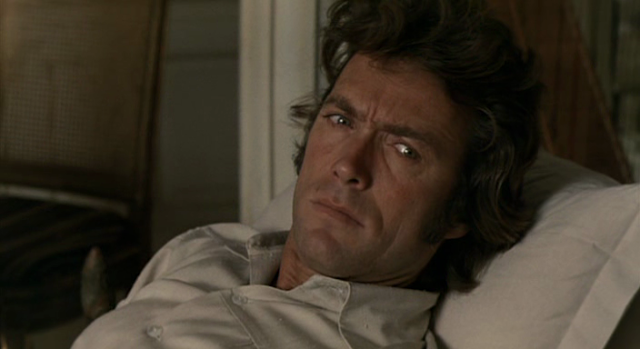
Clint Eastwood in The Beguiled
THE BEGUILED (Donald Siegel, 1971)
BAMcinématek, BAM Rose Cinemas
30 Lafayette Ave. between Ashland Pl. & St. Felix St.
June 26-30
Series runs June 26 – July 11
718-636-4100
www.bam.org
 In conjunction with the theatrical release of Sofia Coppola’s remake of The Beguiled, which earned her the Best Director award at Cannes, BAMcinématek is hosting the sixteen-film series “Southern Gothic,” which begins with, appropriately enough, Don Siegel’s twisted 1971 original, based on Thomas P. Cullinan’s 1966 novel, A Painted Devil. On the outskirts of Mississippi, Union corporal John “McB” McBurney is seriously wounded and found in the woods by twelve-year-old Amy (Pamelyn Ferdin), who has been gathering mushrooms for dinner. The hirsute hunk is brought to Mrs. Farnsworth’s Seminary for Young Ladies to convalesce before Martha Farnsworth (Geraldine Page) turns him over to the Confederates. (The film was shot at the Ashland-Belle Helene Plantation in Louisiana.) Confined to bed until he starts getting around on crutches, McB becomes an object of romantic interest to several of the girls and women in the house, including the kindhearted Edwina (Elizabeth Hartman), who is about to become a partner in the school; the innocent Amy, who compares the wounded soldier to an injured crow; the devilishly wicked Carol (Jo Ann Harris); and Martha herself, who has been running the school and former farm by herself since the death of her beloved brother. Also intrigued by McB’s presence are young students Abigail (Melody Thomas), Lizzie (Peggy Drier), and Janie (Pattye Mattick) while Doris (Darleen Carr) doesn’t understand why they’re all helping the enemy and considers turning him in. The only one seeing the situation clearly is the slave Hallie (blues singer Mae Mercer), who discusses the concept of freedom with the corporal — who is not quite the heroic, Jesus-like figure the girls think he is — in one of the film’s most intelligent scenes. It all reaches its apex one crazy night, setting up quite a finale.
In conjunction with the theatrical release of Sofia Coppola’s remake of The Beguiled, which earned her the Best Director award at Cannes, BAMcinématek is hosting the sixteen-film series “Southern Gothic,” which begins with, appropriately enough, Don Siegel’s twisted 1971 original, based on Thomas P. Cullinan’s 1966 novel, A Painted Devil. On the outskirts of Mississippi, Union corporal John “McB” McBurney is seriously wounded and found in the woods by twelve-year-old Amy (Pamelyn Ferdin), who has been gathering mushrooms for dinner. The hirsute hunk is brought to Mrs. Farnsworth’s Seminary for Young Ladies to convalesce before Martha Farnsworth (Geraldine Page) turns him over to the Confederates. (The film was shot at the Ashland-Belle Helene Plantation in Louisiana.) Confined to bed until he starts getting around on crutches, McB becomes an object of romantic interest to several of the girls and women in the house, including the kindhearted Edwina (Elizabeth Hartman), who is about to become a partner in the school; the innocent Amy, who compares the wounded soldier to an injured crow; the devilishly wicked Carol (Jo Ann Harris); and Martha herself, who has been running the school and former farm by herself since the death of her beloved brother. Also intrigued by McB’s presence are young students Abigail (Melody Thomas), Lizzie (Peggy Drier), and Janie (Pattye Mattick) while Doris (Darleen Carr) doesn’t understand why they’re all helping the enemy and considers turning him in. The only one seeing the situation clearly is the slave Hallie (blues singer Mae Mercer), who discusses the concept of freedom with the corporal — who is not quite the heroic, Jesus-like figure the girls think he is — in one of the film’s most intelligent scenes. It all reaches its apex one crazy night, setting up quite a finale.
The Beguiled was the third of five movies Siegel (Invasion of the Body Snatchers, The Killers) made with Eastwood, after 1968’s Coogan’s Bluff and 1970’s Two Mules for Sister Sarah and before 1971’s Dirty Harry and 1979’s Escape from Alcatraz. It is both a feminist and sexist fantasy that is more than a little bit creepy; the original trailer referred to the females at Mrs. Farnsworth’s seminary as “man-eager girls.” The film also deals with patriotism and treason, incest and pedophilia, trust and lies, first love and sexual jealousy, and a sadomasochistic ideals of pleasure and pain that relates to the painting on Mrs. Farnsworth’s bedroom wall, Sandro Botticelli’s late-fifteenth-century “Lamentation over the Dead Christ.” Six-time Oscar nominee and Emmy and Grammy winner Lalo Schifrin’s score is all over the place, from Baroque and Renaissance music to twentieth-century melodrama and horror; in addition, an offscreen Eastwood himself mumbles the antiwar theme song, “The Dove She Is a Pretty Bird,” heard at the beginning and end of the film. Eastwood is at his stern best in The Beguiled, while Emmy and Oscar winner Page (Interiors, The Trip to Bountiful) is elegantly fragile and Oscar nominee Hartman (A Patch of Blue, Walking Tall) is achingly virginal. (The two women also costarred in Francis Ford Coppola’s underseen You’re a Big Boy Now.) The film, both a love story and a revenge thriller that is very possibly a likely influence on Stephen King’s Misery, constantly borders on misogyny but manages to raise the issue more than exploit it by the grisly end. It’s an extremely strange movie, one of the oddest ever made about the Civil War, and, as the title warns, absolutely beguiling. The Beguiled is screening June 26-30 at BAM; “Southern Gothic” continues through July 11 with such other films as Kasi Lemmons’s Eve’s Bayou, John Huston’s Wise Blood, Andrei Konchalovsky’s Shy People, Robert Aldrich’s Hush, Hush, Sweet Charlotte, and Luis Buñuel’s The Young One.